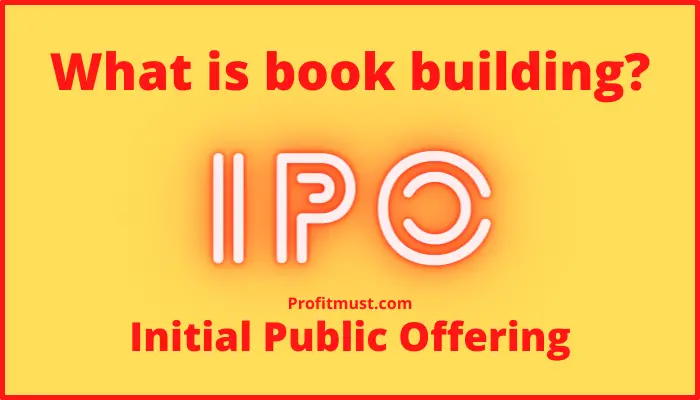An initial public offering, rights issue, or private placement are all ways for a company to raise money in the primary market. The offering of equities to the general public on the main market is known as an Initial Public Offering (IPO). It is the firm ‘s main source of money with a lengthy or indefinite maturity.
Table of Contents
What is Book Building Method?
A process in which a demand for equities proposed to be issued by a body corporate is elicited and built up, and the price for those equities is assessed for the purpose of determining the quantum of such securities to be filed by means of a notice, circular, advertisement, document or information memorandum or offer document in as per the sebi guidelines.
Book building is a method of efficient price identification used in initial public offerings (IPOs). It is a technique in which investors submit bids at different rates that are higher than or equal to the floor price within the IPO’s open period. After the bid deadline, the offer price is decided.
Types of Book building
According to SEBI guidelines, an issuer firm can issue shares to the public via prospectus in the following ways:

- 100% of the net offer to the public via book building method
- 75% of the net offer to the public via book building process and 25% at the price decided through book building Following the Book Built phase, during which the issue price is decided, the Fixed Price section is executed like a typical public issue.
In India, the practice of book building is relatively recent. It is, nevertheless, a widespread practise in the majority of developed nations.
Book Building Process Steps
Afterunderstanding what is book building let’s talk about process. At least two business days before the IPO opens, the issuer of the initial public offering (IPO) announces a price band or floor price.
The bidders submitted bids for the shares, specifying the price and amount they wanted to buy for. Following the completion of the bidding procedure, the cut-off price is determined based on the demand for securities.
The allotment basis is subsequently finalised, and allotment or refund is carried out. The issue process is completed when ROC fills out the final prospectus with all of the information, such as the final issue price and issue size.
Major Steps in Book Building
- Selection of book runners.
- Road shows.
- Issue of Draft Red herring Prospectus.
- SEBI Approval
- Analysis of dates & bids.
- Submission of prospectus to the ROC (Registrar of Companies)
- Fund Raise from anchor investors
- Collection of application forms with funds from the public.
- Allotment of securities.
- Listing
Difference between Fixed Price and Book Building
Stocks are offered at prices over or equivalent to the floor prices in Book Building, whereas shares are issued at a set price in a public offering. In the case of Book Building, the demand may be determined on a daily basis as the book is created. However, in the event of a public issue, the demand is recognized at the end of the process.

Accelerated book-building
When a firm is in desperate need of cash and debt financing isn’t an option, an accelerated book-building is sometimes adopted. This might happen when a company wants to make an acquisition bid to another company.
When a firm can’t get extra funding for a short-term project or acquisition because of its large debt commitments, it might employ an accelerated book-build to get urgent funding from the stock market.
The offer time for an expedited book construction is only one or two days long, with little to no marketing. In other terms, there is a 48-hour window between price and issue.
Important Points about Accelerated Book-Building :
- An accelerated book-building is typically conducted overnight, with the issuing firm contacting a number of investment banks on the evening before the proposed placement to function as underwriters.
- In an auction-style procedure, the issuer invites bids and awards the underwriting contract to the bank that agrees to the maximum backstop price.
- The offer containing the price range is sent to institutional investors by the underwriter. In practise, placement with investors occurs over night, with stock pricing typically taking place within 24 to 48 hours.
Book Building Pricing Risk
When the first price is determined for any IPO, there is a concern that the stock will be overvalued or undervalued. If it is expensive, it may deter investor interest if they are unsure whether the firm’s price reflects its true worth.
This market reaction might lead the price to drop even more, reducing the value of stocks that have already been bought.
When a share is undervalued, it is regarded as a missed chance by the issuing business since it might have produced more cash than were purchased in the first public offering.

Conclusion
Book building process is quite simple & easy if you understand the basics of the stock market. However, it looks difficult while you are a newbie in the stock market.
This is all from our side regarding What is book building? Let us know your views in the comment section.
Other Interesting blogs related to What is book building
Difference Between IPO and FPO
FAQ About What is Book Building?
Book building process steps
Selection of book runners. Road shows. Issue of Draft Red herring Prospectus. SEBI Approval Analysis of dates & bids. Submission of prospectus to the ROC (Registrar of Companies) Fund Raise from anchor investors. Collection of application forms with funds from the public. Allotment of securities. Listing.
Features of book building
The process through which an underwriter tries to identify the price at which an initial public offering (IPO) will be issued is known as book building. Before reaching an issue price, the price identification method includes creating and documenting investor demand for shares.
What is book building method answer in brief?
A process in which a demand for equities proposed to be issued by a body corporate is elicited and built up, and the price for those equities is assessed for the purpose of determining the quantum of such securities to be filed by way of a notice, circular, advertisement, document, information memorandum, or offer document in accordance with the sebi guidelines.
SEBI guidelines for book building
A process in which a demand for equities proposed to be issued by a body corporate is elicited and built up, and the price for those equities is assessed for the purpose of determining the quantum of such securities to be filed by way of a notice, circular, advertisement, document, information memorandum, or offer document in accordance with the sebi guidelines.
Advantages of book building?
In securities, the Exchange provides a national bidding mechanism. It uses the most up-to-date digital trading technologies to provide a fair, efficient, and transparent way for gathering bids. The costs of the IPO are significantly lower than those of a traditional IPO.

